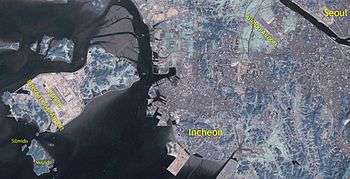209th Detachment, 2325th Group
| 209th Detachment, 2325th Group | |
|---|---|
| Active | April 1, 1968 - August 23, 1971 |
| Country |
|
| Branch |
|
| Type | Black op special forces |
| Role | Assassinate Kim Il-sung |
| Size | 31 |
| Part of | 20th Special Service Squadron |
| Garrison/HQ | Silmido |
| Nickname(s) | Unit 684, Silmido Unit |
209th Detachment, 2325th Group, commonly known as Unit 684, was a black operation team of the Republic of Korea Air Force (ROK Air Force) whose only given task was to assassinate North Korea's premier Kim Il-sung.[1]
Formation
The unit was set up by the Chief of Korean Central Intelligence Agency (KCIA) on the orders of President Park Chung-hee to retaliate for the Blue House Raid on January 19, 1968. The Defense Ministry said the unit was a detachment of the ROK Air Force’s 2325th Group, which recruited 31 civilians, either petty criminals or unemployed youths who were promised money and jobs if they succeeded in their mission.[2]

Similar to North Korea's Unit 124, which had failed to assassinate President Park in the Blue House Raid, Unit 684 was made up of 31 men. Its mission was to assassinate the leader of North Korea, Kim Il-sung. The number of the unit, 684, stands for April 1968, when the unit was founded. The members were harshly trained on the uninhabited island of Silmido, in the Yellow Sea, off the coast of Incheon. Seven members of the unit died during training. Following an improvement in intra-Korean relations, the unit's assassination mission was cancelled.
Mutiny
| Unit 684 Mutiny | |||||||
|---|---|---|---|---|---|---|---|
| Part of Cold War | |||||||
| |||||||
| Belligerents | |||||||
|
|
| ||||||
| Commanders and leaders | |||||||
| Park Chung-hee | Unknown | ||||||
| Strength | |||||||
| Unknown | 24 | ||||||
| Casualties and losses | |||||||
| Unknown |
20 killed 4 captured (later executed) | ||||||
On August 23, 1971, for reasons which remain unclear, the members of Unit 684 rose up and killed all but six of their guards and made their way to the mainland, where they hijacked a bus to Seoul. The bus was stopped by the army in Daebang-dong, Dongjak-gu, Seoul. Twenty members of the unit were shot or committed suicide with hand grenades. The four survivors were sentenced to death by a military tribunal and executed on March 10, 1972.[2]
Aftermath
The South Korean government concealed all information regarding Unit 684 until the 1990s. The unit came to public attention with the release of the film Silmido in 2003, but the government only released an official report on the unit and the uprising in 2006.[3]
In 2009, the families of 21 members of Unit 684 sued the South Korean government for 670 million Korean won in compensation. On May 19, 2010, the Seoul Central District Court ordered that the government pay 273 million Korean won in compensation to the families. The court found that "the Silmido agents were not informed of the level of danger involved with their training, and the harshness of the training violated their basic human rights" and also acknowledged the emotional pain the government caused by not officially disclosing the agents’ deaths to family members until 2006.[3]
See also
- Blue House Raid
- Silmido, a film based on the group
References
- ↑ "<군과거사 규명대상 쟁점.전망>-2(끝)".
- 1 2 Onishi, Norimitsu (15 February 2004). "South Korean Movie Unlocks Door on a Once-Secret Past". The New York Times. Retrieved March 10, 2012.
- 1 2 "Silmido agents' families get $217,000". Joong Ang Daily. 20 May 2010. Retrieved 10 March 2012.
Sources
- The Korea Times: Military Admits 'Silmido Unit' for First Time
- NKIDP: Crisis and Confrontation on the Korean Peninsula: 1968-1969, A Critical Oral History